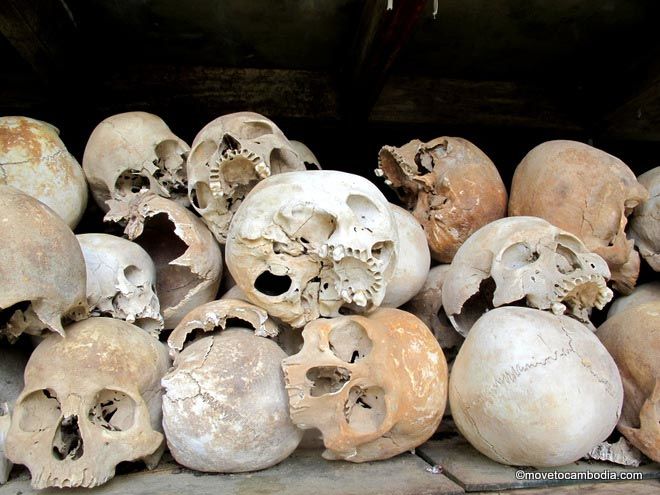The Khmer Rouge were in power for just four years, but the country has yet to fully recover.
Between 1970 and 1975 the fighting between the Lon Nol regime on one side and the North Vietnamese and Khmer Rouge on the other was brutal, leaving hundreds of thousands of Cambodians dead. On April 17, 1975, the Lon Nol government collapsed and the Khmer Rouge, with a Paris-educated intellectual named Pol Pot at the helm, took over and renamed the country Democratic Kampuchea.

Phnom Penh’s infamous S-21 prison, a school that was turned into a torture center.
Within days the Khmer Rouge evacuated Phnom Penh in a radical attempt to restructure Cambodian society. The cities were forcibly emptied and nearly the entire Cambodian population was forced to work as slave laborers in the countryside, where the supposedly more ideologically “pure” peasants were put in charge. The goal was to turn Cambodia into an agrarian, communist society with no religion, no intellectuals, and no currency. The result was one of the most violent and drastic deliberate upheavals ever inflicted on a society.
It did not take long before the Khmer Rouge regime turned on itself, going through a series of violent purges meant to weed out those who were not sufficiently dedicated to the cause. Many leaders of the Khmer Rouge defected to Vietnam, where they put together a government in exile.
In December 1978 the Vietnamese government invaded Cambodia, and by early 1979 Vietnam had liberated Cambodia from the Khmer Rouge and installed a government of its own choosing, made up largely of the Khmer Rouge defectors who’d fled to Vietnam and led by Hun Sen. By this time huge numbers of Cambodians were starving and hundreds of thousands had fled to refugee camps on the Thai border.

Millions of Cambodians died during the Khmer Rouge era.
The Khmer Rouge were in power for less than four years, but during that time between one and three million Cambodians died, close to a quarter of the entire population. Many were executed by the Khmer Rouge, and many more died of starvation and disease. Those who survived had their families ripped apart, were forced to marry complete strangers, were stripped of their culture and religion, saw all their hopes destroyed, and suffered torments most of us can barely imagine.
Though out of power, the Khmer Rouge were still able to put up resistance to the new regime and fighting continued long after the Paris peace agreements were signed in 1991. As part of the agreement, the United Nations undertook to administer the country for two years, in one of the UN’s most ambitious and expensive plans ever. The UN Transitional Authority in Cambodia (UNTAC) was hailed as a success by some and derided as a boondoggle by others. Nevertheless, Cambodia did manage to hold elections in 1993, with more than 90 percent of Cambodians casting votes.
Celebration of democracy proved premature, though. When the Cambodian People’s Party (CPP), led by Hun Sen, did not win the election, the CPP threatened to lead a secession of Cambodia’s eastern provinces. The country bowed to the CPP’s threats and Hun Sen was made the second prime minister (royalist Norodom Ranariddh was the first).
Until this point the Khmer Rouge still had a seat in the UN and were recognized by many Western governments as the legitimate rulers of Cambodia. But after the 1993 elections they were exiled to fighting in the provinces (which is pretty much all they had been doing after 1979 anyway). The following year, 1994, they were outlawed. Defections to the government fractured the group until they eventually disintegrated and the last hardliners surrendered in the late 1990s.
In 1997 Hun Sen ousted his then coalition partner and co-prime minister in a military-backed coup. He’s still in power today.
In 1998 Pol Pot died, never having faced justice for the atrocities committed by the Khmer Rouge under his leadership. That same year the CPP swept the Cambodian elections, as they have ever since. In the intervening years the country has taken small steps toward improvement, including agreeing to allow trials of the remaining top Khmer Rouge leaders by a UN-backed tribunal, a process that is still going on at the time of writing.
The almost three-decade-long war devastated the country, which lost most of its infrastructure, its cultural and educational institutions, and its intellectuals, who were either killed or fled the country. An entire generation of Cambodians was starved, tortured, and traumatized, and there are many who believe that this trauma has been passed down to the next generation. People often blame all of the country’s ills on the Khmer Rouge period, which is a gross oversimplification of the country’s difficult history. But there is no denying that this period had a profound effect on Cambodia’s culture and people that will resonate for generations to come.
If you’d like to know more, we suggest you read up on Cambodia’s history to better understand the country and its people. (We’ve listed some of the best sources in our Suggested reading section.)